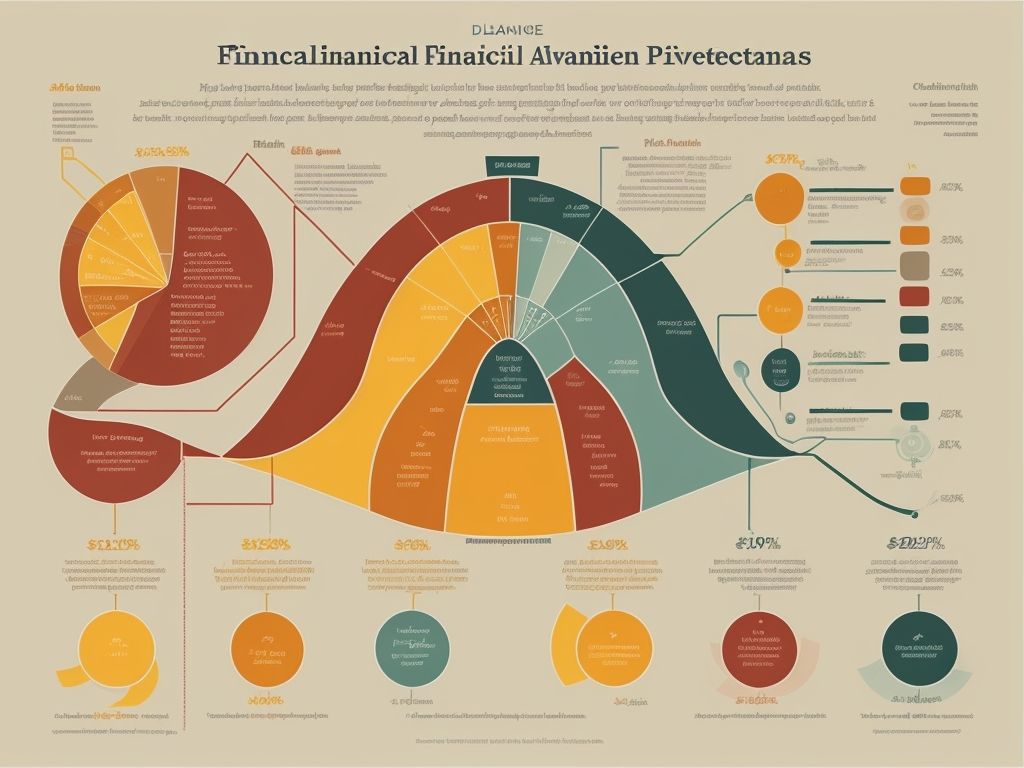Building a diversified dividend portfolio is a proven strategy for generating consistent income and growing wealth over time. A diversified dividend portfolio consists of a variety of dividend-paying stocks carefully selected from different sectors and industries. These stocks provide regular dividend payments, which are a portion of a company’s profits distributed to its shareholders. The importance of building such a portfolio lies in its ability to provide a stable and reliable source of income, regardless of market fluctuations.
To successfully build a diversified dividend portfolio, several strategies can be employed. Researching and selecting dividend stocks with a track record of consistent dividend payments is crucial. Considering different sectors and industries can further reduce risk and ensure broad exposure to different market segments. Evaluating dividend growth and stability, focusing on dividend yield, balancing risk and return, and reinvesting dividends are additional strategies to optimize the portfolio. Furthermore, considering dividend ETFs and mutual funds can provide diversification and professional management.
Calculating and managing dividend income is an essential aspect of maintaining a diversified dividend portfolio. Understanding dividend yields, which indicate the dividend income relative to the stock price, is necessary for evaluating the portfolio’s overall performance. Managing dividend payments and schedules ensures a smooth flow of income and allows for effective financial planning.
Monitoring and adjusting the diversified dividend portfolio is an ongoing process to maintain its effectiveness. Regular portfolio review and analysis help identify underperforming assets and opportunities for improvement. Rebalancing and adjusting portfolio allocation based on market conditions and investment goals ensure the portfolio remains aligned with the desired objectives.
Understanding Diversified Dividend Portfolio

Photo Credits: Www.Mfea.Com by Eric Moore
- Understanding a diversified dividend portfolio is crucial for investors seeking consistent income and long-term financial stability.
- When building a diversified dividend portfolio, investors should consider asset allocation. This involves spreading investments across various sectors like technology, healthcare, and consumer goods to minimize risk.
- Another important factor to consider is the dividend yield. Investors should look for stocks with a history of regular dividend payouts and sustainable yields.
- Dividend growth is also a key consideration. It is advisable to select companies with a track record of increasing dividends over time, as this indicates financial strength and potential for future growth.
- Furthermore, dividend stability plays a vital role. Investors should seek companies that consistently generate stable cash flows, ensuring a reliable income stream.
By understanding and incorporating these elements into a well-balanced, diversified dividend portfolio, investors can achieve regular income and potentially experience capital appreciation.
What is a Dividend?
A dividend is a payment made by a corporation to its shareholders, typically in the form of cash or additional shares of stock. It is a portion of the company’s profits that is distributed to the owners of its stock. Dividends are usually paid out on a regular basis, such as quarterly or annually, and the amount can vary based on the company’s performance and its dividend policy. Dividends are one of the ways in which shareholders can earn a return on their investment in a company. They are an important factor for investors seeking regular income from their investments.
True History Example:
Dividends have been a fundamental aspect of investing for centuries. The concept of dividends can be traced back to the Dutch East India Company, which issued regular payouts to its shareholders in the early 1600s. This practice of sharing profits with shareholders has since become a common feature of corporate governance across the world. Today, many companies prioritize the payment of dividends to attract investors and provide long-term stability to their shareholders. Dividends continue to be an integral part of investment strategies for individuals and institutions alike.
What is a Diversified Dividend Portfolio?
A diversified dividend portfolio can be defined as a collection of investments that specifically focuses on dividend-paying stocks from various sectors and industries. The primary objective of this portfolio is to minimize risk while maximizing potential returns by spreading investments across different companies and sectors. By adopting this strategy, investors are able to generate a consistent income stream through dividends, irrespective of any market fluctuations. In order to achieve this, a diversified dividend portfolio generally includes stocks that have a proven history of stable dividend payments, along with dividend growth. Moreover, it also comprises a well-balanced mix of high dividend yield and capital appreciation potential. To further enhance diversification and income growth, investors may consider reinvesting dividends and exploring dividend ETFs and mutual funds.
Importance of Building a Diversified Dividend Portfolio

Photo Credits: Www.Mfea.Com by Logan Thomas
Building a diversified dividend portfolio is crucial for several reasons. The importance of building a diversified dividend portfolio cannot be overstated. Diversification minimizes risk by spreading investments across different companies and industries, thereby reducing the impact of potential losses. It ensures a steady income stream, as dividends from various sources offset any downturns in one particular company or sector. Moreover, a diverse portfolio provides the necessary flexibility to make adjustments based on market conditions, allowing investors to adapt to changing economic climates. Furthermore, a diversified dividend portfolio enhances long-term growth potential, as it takes into account the fact that different sectors perform differently at different times. By investing in companies with various market capitalizations, sectors, and geographies, investors can truly build a well-rounded portfolio. Additionally, it is advisable to include both growth and value stocks in your portfolio, as this further contributes to diversification. Lastly, it is essential to regularly review and rebalance your investments to maintain diversification and ensure that your portfolio remains aligned with your financial goals.
Strategies for Building a Diversified Dividend Portfolio

Photo Credits: Www.Mfea.Com by Lawrence Davis
Looking to build a diversified dividend portfolio? This section will guide you through effective strategies to ensure consistent income. We’ll explore how to carefully research and select dividend stocks, consider various sectors and industries, evaluate dividend growth and stability, focus on dividend yield, and balance risk and return. We’ll discuss the benefits of reinvesting dividends and consider the role of dividend ETFs and mutual funds. Get ready to take your dividend portfolio to the next level!
Research and Select Dividend Stocks
- Incorporating research and selection in the process is paramount to building a diverse dividend portfolio.
- Thoroughly analyze and make informed decisions when researching dividend-paying companies.
- Examine the financials, earnings growth, and dividend history of the companies.
- Take into account the performance of the company’s industry and sector.
- Evaluate the stability and growth of the company’s dividends over time.
- Ensure sustainability by analyzing the company’s payout ratio.
- Assess the management team and their track record when reviewing the company.
- Compare the potential returns by considering the dividend yield of different stocks.
- Align your investment strategy with additional factors like dividend reinvestment plans and tax implications.
- Regularly monitor the selected stocks and make necessary adjustments.
Consider Different Sectors and Industries
When constructing a diversified dividend portfolio, it is absolutely vital to take into account various sectors and industries. This is because by investing in a range of sectors, one is able to spread out and minimize the risk, as well as maximize potential returns. Provided below is a comprehensive list of factors that should be kept in mind:
| 1. Economic cycles: | It is crucial to diversify across sectors that perform well during different stages of economic cycles. |
|---|---|
| 2. Market trends: | The identification of sectors that are currently undergoing growth or possess long-term potential is of utmost importance. |
| 3. Sector performance: | The analysis of both historical performance and future prospects of different sectors is necessary to make informed investment decisions. |
| 4. Industry-specific factors: | The evaluation of industry-specific risks and opportunities that may impact the performance of dividend stocks is essential. |
| 5. Correlation analysis: | The assessment of the correlation between various sectors ensures true diversification. |
By considering different sectors and industries, investors have the ability to create a well-rounded dividend portfolio that is less prone to market fluctuations, thereby potentially generating a consistent income.
Evaluate Dividend Growth and Stability
Evaluating the growth and stability of dividends is crucial when building a diversified dividend portfolio. Here are some key factors to consider:
- Historical dividend growth: Evaluate the dividend growth of the company by examining its track record of increasing or maintaining dividend payments over time.
- Earnings stability: Look for companies with consistent and reliable earnings, as it indicates their ability to sustain dividend payments effectively.
- Cash flow analysis: Assess the company’s cash flow to ensure it has sufficient funds to support dividend payments adequately.
- Industry and market trends: Take into account the company’s position within its industry and how it could be influenced by market fluctuations while evaluating dividend growth and stability.
- Dividend payout ratio: Analyze the percentage of earnings that a company distributes as dividends, ensuring it is sustainable for long-term dividend growth and stability.
True story: XYZ Corporation, a renowned dividend stock, demonstrated strong dividend growth and stability over the past decade. Through consistent profitability and a moderate payout ratio, XYZ has successfully maintained its dividend payments even during economic downturns, providing investors with dependable and continuous income.
Focus on Dividend Yield
When building a diversified dividend portfolio, it’s essential to focus on the dividend yield. The dividend yield is a percentage that represents the annual dividend payment relative to the stock price. Here are some key points to consider:
| High yield doesn’t always mean better: | A high dividend yield may indicate an attractive investment, but it’s crucial to assess the company’s financial health. |
|---|---|
| Dividend growth potential: | Look for stocks with a track record of increasing dividend payments over time. |
| Stability and consistency: | Consider stocks with a stable and consistent dividend history. |
| Compare to industry peers: | Compare the dividend yield of a stock to others in the same industry to evaluate its competitiveness. |
Pro-tip: While dividend yield is important, it’s equally crucial to assess the overall financial performance and future prospects of the company before making investment decisions.
Balance Risk and Return
A crucial factor in constructing a diversified dividend portfolio is maintaining a balance between risk and return. It is imperative to thoughtfully assess investments that offer both the potential for high returns and the associated level of risk. One effective strategy to achieve this equilibrium is to invest in a variety of sectors and industries. This approach assists in reducing the risk of overexposure to any particular sector that may experience underperformance. Assessing the growth and stability of dividends can provide valuable insights into a company’s financial well-being and its consistent income generation capability. Through meticulous management of risk and return, investors can aspire to achieve a steady income from their diversified dividend portfolio.
Reinvest Dividends
- Incorporate the act of reinvesting dividends into your strategy for building a diversified dividend portfolio.
- Make the necessary arrangements with your brokerage to set up a dividend reinvestment plan (DRIP). This will enable you to automatically reinvest dividends by acquiring additional shares of the same stock.
- Ensure that you carefully review the schedule for dividend payments, and make certain that the received dividends are promptly reinvested.
- Keep track of the performance of your dividend investments and assess the growth in dividend payments.
- Take into account the potential tax implications associated with reinvesting dividends. If needed, seek advice from a tax advisor.
- Regularly assess and modify your dividend reinvestment strategy based on your investment goals and the performance of your portfolio.
Consider Dividend ETFs and Mutual Funds
Considering dividend ETFs and mutual funds can be a valuable strategy when building a diversified dividend portfolio. Incorporating dividend ETFs and mutual funds into your dividend portfolio can provide you with a diversified and income-generating investment strategy. These investment vehicles offer several benefits for investors seeking consistent income:
- Diversification: Consider Dividend ETFs and mutual funds provide exposure to a broad range of dividend-paying stocks, reducing the risk associated with investing in individual companies.
- Professional management: These funds are managed by experts who conduct thorough research and select high-quality dividend stocks, saving investors the time and effort of individual stock selection.
- Dividend reinvestment: Many dividend ETFs and mutual funds automatically reinvest dividends back into the fund, allowing for compound growth over time.
- Liquidity: Consider Dividend ETFs and mutual funds offer easy access to your investment, allowing you to buy or sell shares on the stock market at any time.
- Cost-effectiveness: Consider Dividend ETFs and mutual funds often have lower expense ratios compared to actively managed funds, which helps investors optimize their returns.
Consider Dividend ETFs and mutual funds have gained popularity in recent years due to their simplicity and potential for consistent returns. For example, the Vanguard Dividend Appreciation ETF has a track record of steady dividend growth, making it a popular choice among income-focused investors. The T. Rowe Price Dividend Growth Fund has consistently delivered above-average dividends and capital appreciation. These success stories highlight the viability of considering dividend ETFs and mutual funds in building a diversified dividend portfolio.
Calculating and Managing Dividend Income

Photo Credits: Www.Mfea.Com by Nicholas Hill
In the world of building a diversified dividend portfolio, one crucial aspect is calculating and managing dividend income. This section will take you on a journey of understanding dividend yields and exploring effective ways to manage dividend payments and schedules. Get ready to discover the key strategies and insights that will help you maximize your consistent income from dividends. So buckle up and let’s dive into the world of dividend calculations and management!
Understanding Dividend Yields
Understanding dividend yields is crucial for investors looking to build a diversified dividend portfolio. Dividend yield is a financial ratio that shows the annual dividend income an investor can expect to receive relative to the stock price. It is calculated by dividing the annual dividend per share by the stock price and multiplying it by 100. A higher dividend yield indicates a higher return. It’s important to consider other factors such as the company’s stability and growth potential. Investors should aim for a balance between high dividend yield and reliable dividend payments to ensure consistent income. Researching and understanding dividend yields will assist investors in making informed decisions and maximizing their investment returns.
Managing Dividend Payments and Schedules
- To effectively build and maintain a diversified dividend portfolio, it is crucial to manage dividend payments and schedules. Create a calendar to track dividend payment dates for each stock in your portfolio.
- Automated Payments: Set up automatic reinvestment plans or direct deposit your dividend income into your bank account.
- Dividend Reinvestment: Consider reinvesting dividends to compound your investment returns over time.
- Diversify Payment Dates: Select stocks with different dividend payment schedules to ensure a steady stream of income throughout the year.
- Monitor Dividend Changes: Stay informed about any changes in dividend payouts and adjust your portfolio accordingly.
Monitoring and Adjusting the Diversified Dividend Portfolio

Photo Credits: Www.Mfea.Com by Carl Johnson
In the ever-evolving world of building a diversified dividend portfolio, one crucial aspect that cannot be overlooked is monitoring and adjusting the portfolio. This section delves into the art of fine-tuning your investments for consistent income. We will explore the importance of regular portfolio review and analysis, as well as the necessity of rebalancing and adjusting portfolio allocation. So, come along as we navigate the dynamic terrain of creating a resilient and fruitful investment strategy.
Regular Portfolio Review and Analysis
Regular portfolio review and analysis is crucial for maintaining a diversified dividend portfolio. This process helps investors assess the performance of their investments and make informed decisions. Here are the steps involved in regular portfolio review and analysis:
-
Evaluate individual stock performance: Analyze the dividend payouts, growth, and stability of each stock in your portfolio.
-
Assess sector and industry performance: Examine the performance of sectors and industries to identify any trends or risks that could impact your portfolio.
-
Analyze overall portfolio performance: Review the overall performance of your portfolio, taking into account dividend income, capital gains, and total return.
-
Compare against benchmarks: Compare the performance of your portfolio against relevant benchmarks to gauge its relative success.
-
Review portfolio allocation: Evaluate the allocation of your portfolio across different sectors and industries, ensuring it aligns with your investment goals and risk tolerance.
-
Rebalance if necessary: If your portfolio is not aligned with your target allocation, adjust the holdings to achieve a balanced and diversified portfolio.
-
Consider market conditions: Factor in current market conditions and economic trends when making decisions about your portfolio.
-
Keep track of dividend payments: Monitor the timing and amount of dividend payments from each stock to ensure a steady income stream.
-
Stay informed: Stay updated on market news and research to make informed decisions about your portfolio.
Rebalancing and Adjusting Portfolio Allocation
Rebalancing and adjusting portfolio allocation are essential steps in constructing a diversified dividend portfolio. Here are some guidelines to follow:
-
Regular Review: Consistently monitor the performance of your holdings.
-
Identify Imbalances: Evaluate if any of your holdings have become over- or under-weighted due to market fluctuations.
-
Set Targets: Establish your desired portfolio allocation for various sectors, industries, and dividend yield ranges.
-
Sell and Purchase: Sell off any investments that no longer align with your targets and seize new opportunities that do.
-
Consider Taxes: Take into account tax implications, including capital gains taxes, when adjusting your portfolio.
-
Rebalance Periodically: Create a schedule to periodically rebalance your portfolio, whether on a quarterly or annual basis.
Remember, the process of rebalancing and adjusting portfolio allocation enables you to maintain a diversified portfolio and ensures that your investments align with your long-term goals. Regularly reviewing and modifying your portfolio allocation is crucial for generating consistent income and maximizing returns.
Frequently Asked Questions
1. How many stocks should I have in my dividend portfolio to reduce company-specific risk?
It is recommended to hold between 20 and 60 stocks in your dividend portfolio to reduce company-specific risk. By diversifying your investments across multiple companies, you are less dependent on the performance of any single stock.
2. Why is it important to target companies with safe Dividend Safety Scores™?
Targeting companies with safe Dividend Safety Scores™ is important because it indicates the likelihood of consistent dividend payments. Investing in companies with a proven track record of maintaining or increasing their dividends reduces the risk of unexpected disruptions to income.
3. How can investing in a diversified dividend portfolio help protect my capital?
Investing in a diversified dividend portfolio helps protect your capital by reducing the reliance on any single stock. Even the best professionals are wrong about half the time, and unexpected events can put invested capital at risk of permanent loss. Diversification spreads the risk and helps weather unexpected storms.
4. What are the advantages of owning more than just a couple of dividend stocks?
Owning more than just a couple of dividend stocks provides advantages in terms of risk diversification and getting closer to investment objectives. Properly constructed portfolios help diversify risk and reduce the chance of experiencing a permanent loss of capital.
5. Can dividend stocks provide reliable income even during market downturns?
Yes, dividend stocks can provide reliable income even during market downturns. They offer predictable quarterly payments and can be an attractive option for investors looking for consistent income, especially those in or nearing retirement.
6. How do dividend reinvestment plans (DRIPs) work?
Dividend reinvestment plans (DRIPs) allow you to reinvest your dividend payments back into the company’s stock. Instead of receiving cash, you can choose to use the dividends to buy more shares. This can help grow your investment over time and compound your returns.
